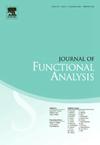Hölder具有软势的稳定玻尔兹曼方程解的规律性
IF 1.6
2区 数学
Q1 MATHEMATICS
引用次数: 0
摘要
我们考虑有界和严格凸域内具有流动边界条件的稳定玻尔兹曼方程解的Hölder正则性对于具有截止软势(−3<γ<0)的气体Ω∧R3。证明了在空间和速度上存在一个具有有界L∞范数的唯一解。该解是Hölder连续的,其阶数不仅取决于输入边界数据的规律性,还取决于势幂γ。调制软势情形−2<;γ<;0的结果与硬势情形(0≤γ<1)相似,因为我们从碰撞部分得到了C1速度规律。然而,我们观察到,对于极软势情况(−3<γ≤−2),碰撞部分得到的速度规律性较低(仅Hölder),但在γ的限制下,边界规律性仍然可以通过输运和碰撞部分传递到解(在空间和速度上)。本文章由计算机程序翻译,如有差异,请以英文原文为准。
Hölder regularity of solutions of the steady Boltzmann equation with soft potentials
We consider the Hölder regularity of solutions to the steady Boltzmann equation with in-flow boundary condition in bounded and strictly convex domains for gases with cutoff soft potential . We prove that there is a unique solution with a bounded norm in space and velocity. This solution is Hölder continuous, and its order depends not only on the regularity of the incoming boundary data, but also on the potential power γ. The result for modulated soft potential case is similar to hard potential case since we have velocity regularity from collision part. However, we observe that for very soft potential case , the regularity in velocity obtained by the collision part is lower (Hölder only), but the boundary regularity still can transfer to solution (in both space and velocity) by transport and collision part under the restriction of γ.
求助全文
通过发布文献求助,成功后即可免费获取论文全文。
去求助
来源期刊
CiteScore
3.20
自引率
5.90%
发文量
271
审稿时长
7.5 months
期刊介绍:
The Journal of Functional Analysis presents original research papers in all scientific disciplines in which modern functional analysis plays a basic role. Articles by scientists in a variety of interdisciplinary areas are published.
Research Areas Include:
• Significant applications of functional analysis, including those to other areas of mathematics
• New developments in functional analysis
• Contributions to important problems in and challenges to functional analysis

 求助内容:
求助内容: 应助结果提醒方式:
应助结果提醒方式:


